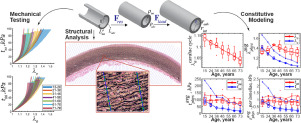当前位置:
X-MOL 学术
›
Acta Biomater.
›
论文详情
Our official English website, www.x-mol.net, welcomes your
feedback! (Note: you will need to create a separate account there.)
Mechanical and structural changes in human thoracic aortas with age.
Acta Biomaterialia ( IF 9.4 ) Pub Date : 2019-12-23 , DOI: 10.1016/j.actbio.2019.12.024 Majid Jadidi 1 , Mahmoud Habibnezhad 2 , Eric Anttila 1 , Kaspars Maleckis 3 , Anastasia Desyatova 3 , Jason MacTaggart 4 , Alexey Kamenskiy 3
Acta Biomaterialia ( IF 9.4 ) Pub Date : 2019-12-23 , DOI: 10.1016/j.actbio.2019.12.024 Majid Jadidi 1 , Mahmoud Habibnezhad 2 , Eric Anttila 1 , Kaspars Maleckis 3 , Anastasia Desyatova 3 , Jason MacTaggart 4 , Alexey Kamenskiy 3
Affiliation

|
Aortic mechanical and structural characteristics have profound effects on pathophysiology, but many aspects of physiologic stress-stretch state and intramural changes due to aging remain poorly understood in human tissues. While difficult to assess in vivo due to residual stresses and pre-stretch, physiologic stress-stretch characteristics can be calculated using experimentally-measured mechanical properties and constitutive modeling. Mechanical properties of 76 human descending thoracic aortas (TA) from 13 to 78-year-old donors (mean age 51±18 years) were measured using multi-ratio planar biaxial extension. Constitutive parameters were derived for aortas in 7 age groups, and the physiologic stress-stretch state was calculated. Intramural characteristics were quantified from histological images and related to aortic morphometry and mechanics. TA stiffness increased with age, and aortas became more nonlinear and anisotropic. Systolic and diastolic elastic energy available for pulsation decreased with age from 30 to 8 kPa and from 18 to 5 kPa, respectively. Cardiac cycle circumferential stretch dropped from 1.14 to 1.04, and circumferential and longitudinal physiologic stresses decreased with age from 90 to 72 kPa and from 90 to 17 kPa, respectively. Aortic wall thickness and radii increased with age, while the density of elastin in the tunica media decreased. The number of elastic lamellae and circumferential physiologic stress per lamellae unit remained constant with age at 102±10 and 0.85±0.04 kPa, respectively. Characterization of mechanical, physiological, and structural features in human aortas of different ages can help understand aortic pathology, inform the development of animal models that simulate human aging, and assist with designing devices for open and endovascular aortic repairs. STATEMENT OF SIGNIFICANCE: This manuscript describes mechanical and structural changes occurring in human thoracic aortas with age, and presents material parameters for 4 commonly used constitutive models. Presented data can help better understand aortic pathology, inform the development of animal models that simulate human aging, and assist with designing devices for open and endovascular aortic repairs.
中文翻译:

人胸主动脉的机械和结构随着年龄的变化而变化。
主动脉的机械和结构特征对病理生理学具有深远的影响,但是在人体组织中,由于衰老引起的生理应力-拉伸状态和壁内变化的许多方面仍然知之甚少。虽然由于残余应力和预拉伸而难以在体内进行评估,但是可以使用实验测量的机械性能和本构模型来计算生理应力-拉伸特性。使用多比例平面双轴拉伸技术测量了76位13至78岁供体(平均年龄51±18岁)的人降胸主动脉(TA)的力学性能。推导了7个年龄组主动脉的本构参数,并计算了生理应力-拉伸状态。从组织学图像量化壁内特征,并与主动脉形态和力学有关。TA刚度随年龄增长而增加,主动脉变得更加非线性和各向异性。随着年龄的增长,可用于脉动的收缩和舒张弹性能量分别从30 kPa降低到8 kPa,从18 kPa降低到5 kPa。心脏循环的周向拉伸度从1.14下降至1.04,并且周向和纵向生理应力分别随年龄从90 kPa降低至72 kPa和从90 kPa降低至17 kPa。主动脉壁厚度和半径随着年龄的增长而增加,而中膜中弹性蛋白的密度则下降。弹性薄片的数量和每个薄片单元的圆周生理应力随年龄分别保持恒定,分别为102±10和0.85±0.04 kPa。表征不同年龄的人类主动脉的机械,生理和结构特征有助于了解主动脉病理,告知模拟人类衰老的动物模型的开发,并协助设计用于开放式和血管内主动脉修复的设备。意义声明:该手稿描述了人类胸主动脉随年龄增长而发生的机械和结构变化,并提供了4种常用本构模型的材料参数。呈现的数据可以帮助更好地了解主动脉病理,为模拟人类衰老的动物模型的发展提供信息,并协助设计用于开放式和血管内主动脉修复的设备。并提供了4种常用本构模型的材料参数。呈现的数据可以帮助更好地了解主动脉病理,为模拟人类衰老的动物模型的发展提供信息,并协助设计用于开放式和血管内主动脉修复的设备。并提供了4种常用本构模型的材料参数。呈现的数据可以帮助更好地了解主动脉病理,为模拟人类衰老的动物模型的发展提供信息,并协助设计用于开放式和血管内主动脉修复的设备。
更新日期:2019-12-23
中文翻译:

人胸主动脉的机械和结构随着年龄的变化而变化。
主动脉的机械和结构特征对病理生理学具有深远的影响,但是在人体组织中,由于衰老引起的生理应力-拉伸状态和壁内变化的许多方面仍然知之甚少。虽然由于残余应力和预拉伸而难以在体内进行评估,但是可以使用实验测量的机械性能和本构模型来计算生理应力-拉伸特性。使用多比例平面双轴拉伸技术测量了76位13至78岁供体(平均年龄51±18岁)的人降胸主动脉(TA)的力学性能。推导了7个年龄组主动脉的本构参数,并计算了生理应力-拉伸状态。从组织学图像量化壁内特征,并与主动脉形态和力学有关。TA刚度随年龄增长而增加,主动脉变得更加非线性和各向异性。随着年龄的增长,可用于脉动的收缩和舒张弹性能量分别从30 kPa降低到8 kPa,从18 kPa降低到5 kPa。心脏循环的周向拉伸度从1.14下降至1.04,并且周向和纵向生理应力分别随年龄从90 kPa降低至72 kPa和从90 kPa降低至17 kPa。主动脉壁厚度和半径随着年龄的增长而增加,而中膜中弹性蛋白的密度则下降。弹性薄片的数量和每个薄片单元的圆周生理应力随年龄分别保持恒定,分别为102±10和0.85±0.04 kPa。表征不同年龄的人类主动脉的机械,生理和结构特征有助于了解主动脉病理,告知模拟人类衰老的动物模型的开发,并协助设计用于开放式和血管内主动脉修复的设备。意义声明:该手稿描述了人类胸主动脉随年龄增长而发生的机械和结构变化,并提供了4种常用本构模型的材料参数。呈现的数据可以帮助更好地了解主动脉病理,为模拟人类衰老的动物模型的发展提供信息,并协助设计用于开放式和血管内主动脉修复的设备。并提供了4种常用本构模型的材料参数。呈现的数据可以帮助更好地了解主动脉病理,为模拟人类衰老的动物模型的发展提供信息,并协助设计用于开放式和血管内主动脉修复的设备。并提供了4种常用本构模型的材料参数。呈现的数据可以帮助更好地了解主动脉病理,为模拟人类衰老的动物模型的发展提供信息,并协助设计用于开放式和血管内主动脉修复的设备。











































 京公网安备 11010802027423号
京公网安备 11010802027423号